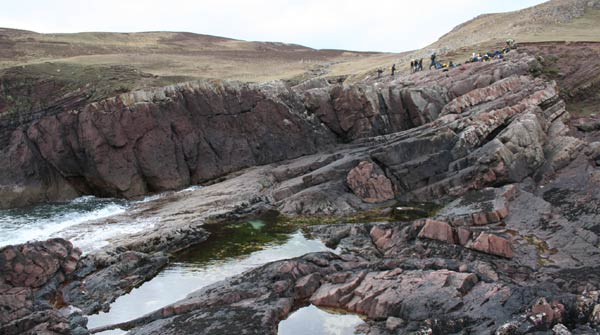
| Home | Geological History | Stratigraphy | Area map | Rock Index | About |
| Scourie | Achmelvich | Laxford | Clachtoll | Stoer | Assynt | Skiag Bridge | Glencoul | Knockan | Borralan | Ledmore |
From Stac Fada, Bay of Stoer

![]() Meteorite impact deposit, Stoer Group (Torridonian), Bay of
Stoer
Meteorite impact deposit, Stoer Group (Torridonian), Bay of
Stoer
This rock type occurs as a single sheet, several metres
thick, showing no bedding or layering. It is a resistant rock
forming a promontory that projects out to sea. The main part of it
can be seen in the left centre of this view forming dark,
purplish vertical faces. Below it, to the right, are bedded
sandstones, and above (top left) are thinly layered limestones
laid down in a lake. The rock (which can be seen at several
locations spread over 50 km north to south) has previously been
described as a volcanic mudflow - the only volcanic feature in
the Stoer Group - but recently Ken Amor from Oxford has found
quartz grains in it showing the type of shock metamorphism found
at meteorite impact sites. Chemical studies also support the
new interpretation that this is part of the blanket of debris
thrown out of an impact crater that is probably now buried beneath
younger rocks out to sea.
A number of features suggest that the rock was forcefully emplaced as a warm, fast-moving flow. Towards the bottom right of the photo there are several large slabs of light brown sandstone that have been torn up from the rocks beneath, tilted and folded.
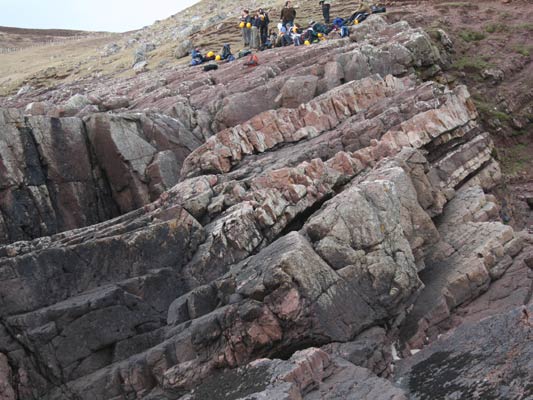
![]() Meteorite impact deposit, Stoer Group (Torridonian), Bay of
Stoer
Meteorite impact deposit, Stoer Group (Torridonian), Bay of
Stoer
This is a more detailed view of the lower part of the deposit,
where it appears to have been injected, from left to right, between
the layers of light brown sandstone.
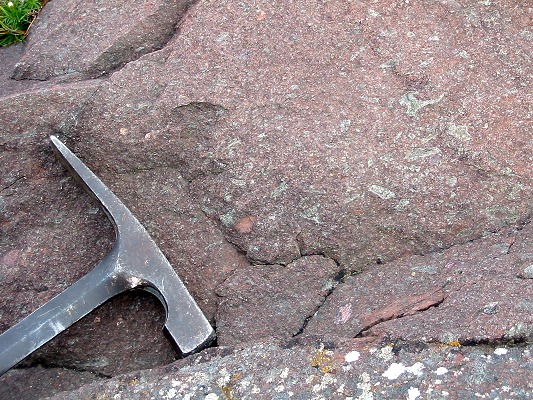
![]() Meteorite impact deposit, Stoer Group (Torridonian), Bay of
Stoer
Meteorite impact deposit, Stoer Group (Torridonian), Bay of
Stoer
This close-up view of the rock shows angular fragments of a
greenish material that resembles a glassy volcanic rock,
suspended in purple muddy sandstone. Also suspended in the
rock are a couple of
fragments of red-brown siltstone. The hammer head is about
15 cm across.
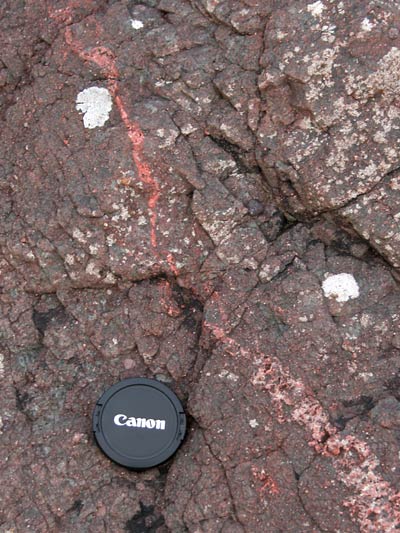
![]() Meteorite impact deposit, Stoer Group (Torridonian), Bay of
Stoer
Meteorite impact deposit, Stoer Group (Torridonian), Bay of
Stoer
A number of features suggest that the rock was hot when
deposited. In this view, a vein of pink feldspar shows the
path along which hot water escaped upwards, precipitating its
dissolved mineral content, as the deposit settled and cooled.
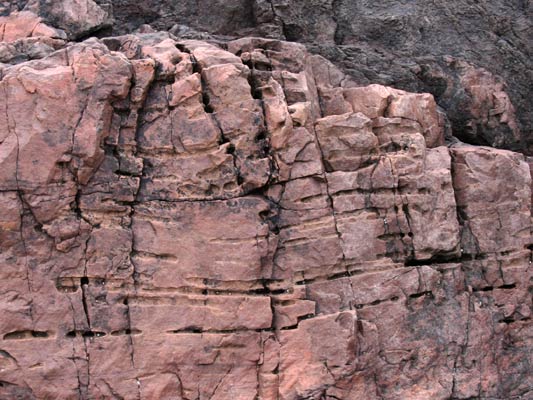
![]() Meteorite impact deposit, Stoer Group (Torridonian), Bay of
Stoer
Meteorite impact deposit, Stoer Group (Torridonian), Bay of
Stoer
Another indication of high temperatures: this is a detail of
one of the folded blocks of sandstone picked up by the flow.
It contains many tube-shaped holes, parallel to its bedding,
each about 2cm in diameter. It is possible that these were
formed and filled by steam boiled out of the sediment's
pore water.
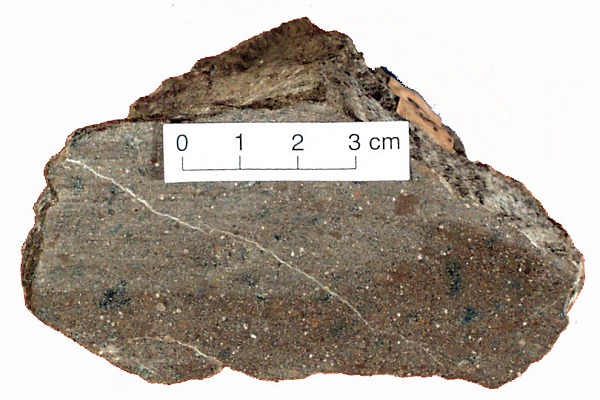
![]() Meteorite impact deposit, Stoer Group
(Torridonian), Bay of Stoer
Meteorite impact deposit, Stoer Group
(Torridonian), Bay of Stoer
This hand specimen consists of angular fragments of dark
green rock of volcanic appearance
and sand grains (quartz and white feldspar) in a
purplish-brown matrix. There is no layering - the rock has
no bedding. The material caught up in it is a mixture of
altered glass (interpreted as bedrock melted at the impact
site) and recycled sedimentary grains.
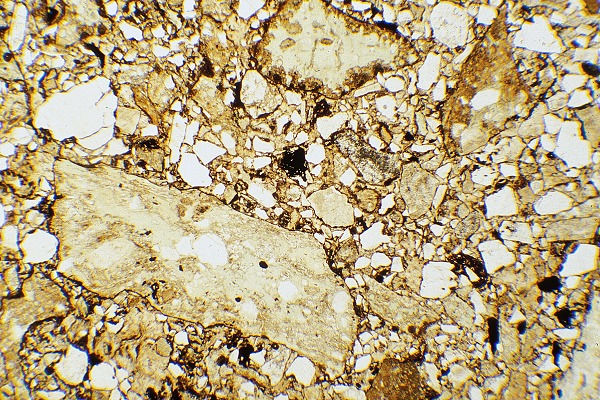
![]() Meteorite impact deposit, Stoer Group
(Torridonian), Bay of Stoer
Meteorite impact deposit, Stoer Group
(Torridonian), Bay of Stoer
At first sight in thin section, the rock looks like a
sandstone. However, the grains are very angular and poorly
sorted, and there is no bedding. The larger fragments are
of a yellowish-green rock that is poorly crystalline and
sometimes shows a banding: it is an altered glassy rock,
solidified from a melt, and its banding was produced by
flow just before it
solidified. The smaller angular grains are cloudy feldspar
and clear quartz: they will have been recycled from other
Torridonian sediments.
Plane polarized light, field of view 7 mm across.
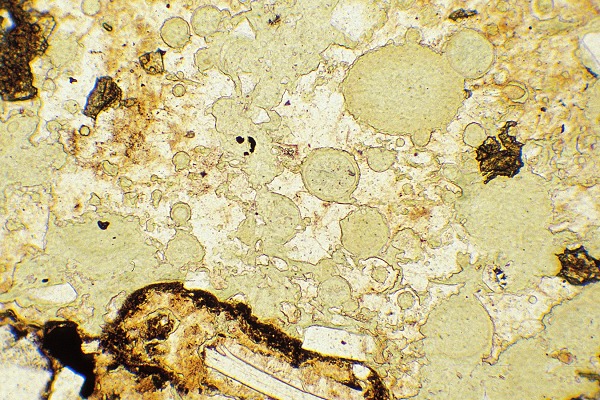
![]() Meteorite impact deposit, Stoer Group
(Torridonian), Bay of Stoer
Meteorite impact deposit, Stoer Group
(Torridonian), Bay of Stoer
This is a detailed view of one of the igneous fragments.
Natural glass (such as obsidian) will eventually begin to
crystallize, even at low temperature. The new crystals are
extremely small (the textures can be called
microcrystalline or cryptocrystalline), and
in some cases many crystals begin to grow at the same point
and build a spherical radiating cluster of needle-like
crystals. Most of this field of view is crystallized glass.
The round objects are radiating aggregates of green
chlorite (a hydrated iron-magnesium silicate), and the
colourless material in between them is microcrystalline
quartz and feldspar.
Plane polarized light, field of view 3 mm across
| Scourie | Achmelvich | Laxford | Clachtoll | Stoer | Assynt | Skiag Bridge | Glencoul | Knockan | Borralan | Ledmore |
| Home | Geological History | Stratigraphy | Area map | Rock Index | About |
D.J. Waters, Department of Earth Sciences, June 2008